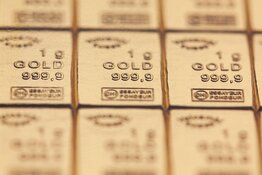Stock and commodity markets edged lower and U.S. Treasury bonds gained, as investors began to digest the implications of this week's Euro Summit deal.
As we headed towards the weekend, gold prices were hovering around $1,737 per ounce—5.9% higher than last week's close, and set for their biggest weekly gain since August.
"The outlook into next week should remain cautious," ones one gold dealer in London.
"Gold's return to form [however], after a period of indifferent performance, will have won it back some supporters, especially since this week's initial rally ran contrary to equities.
Silver prices were up over 12% for the week by Friday lunchtime—at around $35.20 per ounce.
Based on Friday-to-Friday London Fix prices, silver looked set for its biggest weekly gain since May 2009.
European Financial Stability Facility chief executive Klaus Regling held meetings with officials from China's central bank and finance ministry Friday, following yesterday's announcement by European leaders that they will leverage the resources of the EFSF—the Eurozone's bailout fund—possibly by setting up a special purpose vehicle to attract investment.
China has been "a good, loyal buyer" of EFSF-issued bonds said Regling, adding that around 40% of EFSF bonds issued to date are held by Asian investors—though he declined to reveal how many were specifically in Chinese hands.
"I am optimistic that we will have also a longer-term relationship because we will continue to provide safe, attractive investment opportunities."
The EFSF is rated triple-A by all three major ratings agencies.
Regling's visit follows Thursday's telephone conference between China's president Hu Jintao and French president Nicolas Sarkozy.
"Our independence will in no way be put into question by this," insisted Sarkozy yesterday.
"It is in China's long-term and intrinsic interest to help Europe," adds Li Daokui, academic member of China's central bank monetary policy committee.
"They are our biggest trading partner but the chief concern of the Chinese government is how to explain this decision to our own people. . .the last thing China wants is to throw away the country's wealth and be seen as just a source of dumb money."
"As a Chinese saying goes, a crisis always contains opportunities in itself," notes an editorial on the website of China's state-run news agency Xinhua, adding that "strategic vision is needed."
"The issue as to recognition of China's full market economy status has long been a stumbling block to the development of China-EU relations. . .European leaders, especially those of great insight, have begun to reflect on the problem, but any delays in seeking a solution, along with persistent practice of protectionism in the name of fair trade, is a clear sign of shortsightedness."
Back in Europe, there are fears that the continent's banks could be facing a credit market freeze, according to news agency Bloomberg.
Over $1 trillion of debt must be refinanced next year, the newswire reports, but banks are struggling to roll that over by selling new bonds, with more and more relying on short-term emergency funding from the European Central Bank.
"If banks can't fund themselves, they'll struggle to exist," says David Moss, director at F&C Asset Management.
In addition to debt refinancing, some banks say they will need to raise billions if they are meet the 9% capital ratio requirement announced at this week's Euro Summit.
"There is talk about Europe-wide bank guarantees [for bank-issued bonds], but it is not clear yet how that would work," adds Alberto Gallo, head of European credit strategy at Royal Bank of Scotland.
"What is clear is that the EFSF doesn't have enough fire-power to support this as well as standing behind the sovereigns and any bank recapitalizations."
A key indicator of banks' wariness to lend this week hit its worst level since July 2009 according to Bloomberg data.
The spread between 3-month Dollar Libor (the rate at which banks lend Dollars to other banks for three months) and the overnight indexed swap rate (a lower fixed rate as interest rate swaps are considered less risky than cash lending) hit 34.5 basis points (0.345 percentage points) on Wednesday.
The Libor-OIS spread is viewed as a measure of money market stress, tending to rise when banks perceive the risk of lending to each other is greater. Libor-OIS spreads have risen sharply since the start of August—when they were around 12 bps—though they remain way below levels hit just before the Lehman shock of September 2008, when they spiked to over 350 bps.
Over in the U.S., Goldman Sachs considers five potential monetary policy developments in a new research note:
- Raising the inflation target
- Targeting a price level, rather than a rate-of-change of prices
- Targeting nominal GDP
- Targeting the exchange rate
"We think nominal GDP targeting probably provides the best way of communicating a credible intention to deliver a more aggressive easing without taking risks on long-term inflation," says the report.
Gold prices "should slowly drift higher" in the near-term, reckons Jeremy Friesen, commodities strategist at Societe Generale.
"The market will focus on how central banks across the board are going to shift from neutral or tightening to accommodative or aggressively accommodative policy."
Ben Traynor
BullionVault
Editor of Gold News, the analysis and investment research site from world-leading gold ownership service BullionVault, Ben Traynor was formerly editor of the Fleet Street Letter, the UK's longest-running investment letter. A Cambridge economics graduate, he is a professional writer and editor with a specialist interest in monetary economics.
(c) BullionVault 2011
Please Note: This article is to inform your thinking, not lead it. Only you can decide the best place for your money, and any decision you make will put your money at risk. Information or data included here may have already been overtaken by events—and must be verified elsewhere—should you choose to act on it.













































